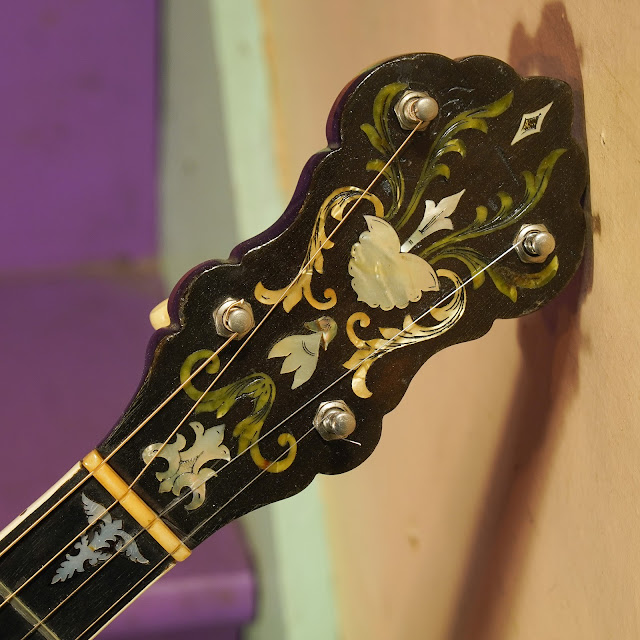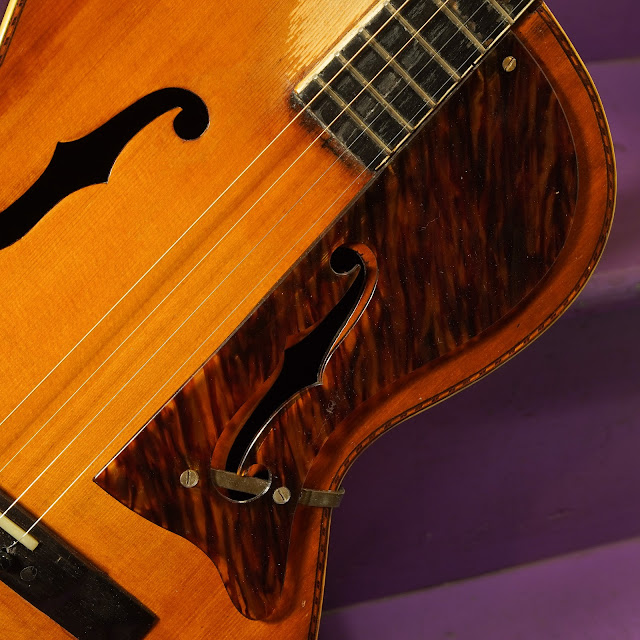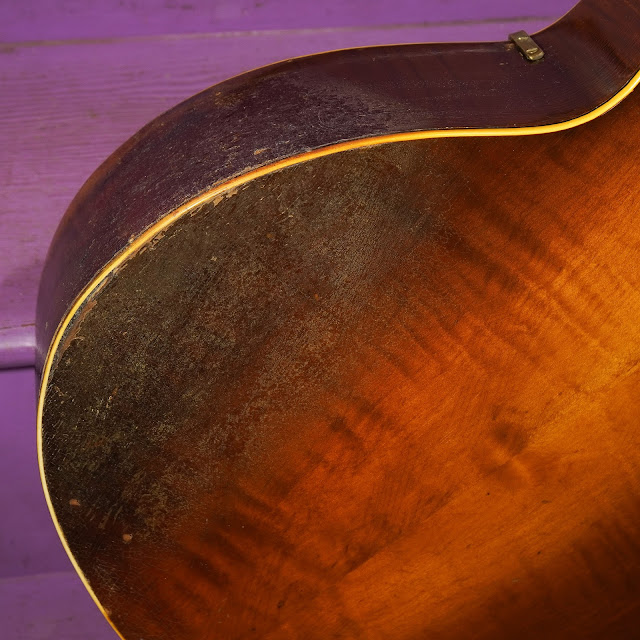1930s Vega Cylinder-Top Plectrum Guitar
Vega cylinder-top guitars of any stripe are rare as heck. To find a plectrum model with the f-holes (rather than round-hole) and fancy inlay in the neck is rare indeed. My jaw almost dropped when my friend Paul brought this by and I cracked the case. Fortunately, I'm used to minor instrument miracles, so I didn't gasp.
For those not in the know, Vega's cylinder-top instruments generally feature a "cylindrical" top and back like this guy does. It's a different way to do an "archtop" design -- the top and back are heat-pressed into a bulge in the middle that stiffens the wood a bit and allows for lighter bracing. While a "normal" archtop design would then fit a tailpiece and floating bridge, Vega did the "crazy" thing of fitting a glued, pin-bridge design to the top instead
This gives the instrument a completely different voice from anything else, really. It's got some of the lingering sweetness, warmth, and sustain of a flattop but mixed with a zippy, gypsy-jazzy, punchy snap borrowed from the archtop sound. When you have this tuned to modal or open, it sounds an awful lot like a high-glass "guitar-bouzouki" or the like... with a sweet chime and shimmer and a presence that shoots right out into the room. Yeah, I'm gushing. It's nice!
It arrived with some funk attached, though -- old, some good/some mediocre repairs, and water damage to the side and back that had separated the seams. It also had a wonky neck reset attempt and a ticky-tacky refret job done to it. The finish appears to be original throughout but I believe the headstock's face is oversprayed. Clearly someone played the bajeez out of it considering the pickwear next to the fretboard extension. The awesome, cut-with-an-f-hole pickguard is original equipment but its mounting hardware is non-original (the original gear -- broken -- is in the case pocket). Amazingly, the instrument is crack-free, too, save chip-out in the fretboard and one hairline crack on the fretboard extension.
This time around, though, I've righted all the faults and now it's a fast-playing, easy-handling instrument. The neck is rather slim for the time and quite quick and there's plenty of saddle height for later adjustments if necessary.
Repairs included: neck reset, fret level/dress, bridge pin hole relocations, saddle fit, pickguard fitting, seam repairs, brace regluing, setup, etc...
Top wood: solid spruce (press-arched)
Back & sides wood: solid flamed maple (press-arched back)
Bracing type: ladder
Bridge: ebony, pyramid-shaped
Fretboard: ebonized maple (I believe)
Neck wood: maple
Action height at 12th fret: 1/16" overall
String gauges: 30w, 20w, 13, 10 for DGBE/CGBD tunings or related
Neck shape: slim-med C
Board radius: flat
Neck relief: straight
Fret style: medium-lower
Scale length: 25 3/8"
Nut width: 1 3/8"
Body width: 14 5/8"
Body depth: 4 5/8"
Weight: 3 lbs 6 oz
Condition notes: it has a lot of finish blem to the lower-bout-treble side and same area on the back. This is water damage/moisture damage but on the inside it's glued-up and secure. There's clearly a lot of pickwear near the fretboard extension, too, and mild scratching, nicks, and dings throughout the finish on the body. The fretboard has a bunch of chipping-out and mild patches of fill from -- presumably -- when it was refretted by a hobbyist. I've reseated all of these newer frets and leveled/dressed any mild neck relief or misfitting of the frets out of the neck via the fret level/dress process. The bridge has had its pinholes filled and redrilled twice, now, with my job the last one. The saddle slot was also filled and recut some time back. One tuner is a replacement but of the same type and period. All fittings aside from said tuner, saddle, and pins appear to be original.
There's a small bit of replacement wood at the binding right next to the neck joint on the top. There's a hidden bolt-reinforcement in the bottom of the heel that runs into the neck block -- thus when I "reset" the neck I removed the fretboard extension, heated up the joint until it was loose, and then backfilled glue and shims into the joint to set the neck more securely and at the right pitch.
It comes with: a presumably-original hard case with corresponding moisture damage in one corner.



























Comments